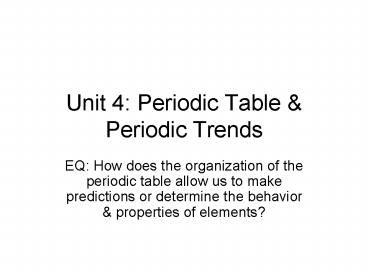Unit 4: Periodic Table - PowerPoint PPT Presentation
1 / 21
Title:
Unit 4: Periodic Table
Description:
Unit 4: Periodic Table & Periodic Trends EQ: How does the organization of the periodic table allow us to make predictions or determine the behavior & properties of ... – PowerPoint PPT presentation
Number of Views:110
Avg rating:3.0/5.0
Title: Unit 4: Periodic Table
1
Unit 4 Periodic Table Periodic Trends
- EQ How does the organization of the periodic
table allow us to make predictions or determine
the behavior properties of elements?
2
GPS
- SC4. Students will use the organization of the
Periodic Table to predict properties of elements. - a. Use the Periodic Table to predict periodic
trends including atomic radii, ionic radii, - ionization energy, and electronegativity of
various elements. - b. Compare and contrast trends in the chemical
and physical properties of elements and - their placement on the Periodic Table.
3
Key Vocabulary Terms
- Law of Octaves
- Periodic Table
- Periodic Law
- Periods
- Group/ Family
- Valence Electron
- Periodic Trends
- Atomic Radius
- Ionic Radius
- Ionization Energy
- Electronegativity
- Electron Affinity
4
The History
- Dobereiner
- Found elements could be put in Triads
- Newlands
- Discovered the Octet Rule when classifying
elements - Mendeleev
- First to organize elements by increasing mass to
create the Periodic Table
5
J. W. Dobereiner (1780-1849)
- Observed that several elements could be
classified into sets of three a.k.a. Triads - His Triads included.
- Lithium, Sodium, and Potassium
- Calcium, Strontium, and Barium
- Chlorine, Bromine, and Iodine
6
Triads
- Grouped By Similar Chemical Properties
- Many Properties of Middle Elements Are
Approximate Averages Of The Properties Of The 1st
And 3rd Element
7
EXAMPLE
ELEMENT ATOMIC MASS Density
Cl 39.5 1.56
Br 79.9 3.12
L 126.9 4.95
8
J.A.R. Newlands (1837-1898)
- Presented the idea that when the elements were
arranged in order of increasing atomic mass, the
properties of every eighth element was like that
of the first in the set1st-8th, 2nd-9th, and so
on - Called the pattern the law of octaves
9
Dmitri Mendeleev (1834-1907) Lothar Myer
(1830-1895)
- Published nearly identical schemes for
classifying the elements - Mendeleev is given more credit since he published
first and was more successful at demonstrating it - Mendeleev also put breaks in the Table where
other elements were yet to be found b/c he knew
they had to fit in to make the table work right
10
Mendeleev
- Noticed that when he arranged the elements by
increasing atomic mass he could see a periodic
repetition of their properties - Used this to create the first Periodic Table
- Wanted to make the elements easier to learn and
understand
11
Moseley
- Moseley
- Developed atomic number concept for the atom
- Arranged elements by increasing atomic number
rather than mass as Mendeleev had
12
The Periodic Law
- when elements are arranged in order of
increasing atomic number, their physical and
chemical properties show a periodic pattern
13
A. Periodic Law
- When elements are arranged in order of increasing
atomic , elements with similar properties appear
at regular intervals.
14
Reading the Table
- Groups/Families are elements with similar
properties and run up and down. There are 18
families. - Periods run left to right on the table. There
are 7 periods.
- Groups to remember
- (1)- Alkali Metals
- (2)- Alkaline-earth Metals
- (3-12)- Transition Metals d-block
- Inner transition Metals (bottom) f-block
- (17)-Halogens
- (18)- Nobel Gases
15
Reading the Table (Cont.)
- Metals
- Have luster (a shine)
- Good conductors (of heat electricity)
- Solids usually
- Malleable (can be pounded into sheets)
- Ductile (pulled into a wire)
- Nonmetals
- No luster
- Poor conductors
- Many are Gases
- Big variation in physical properties
- Metalloids/ semi-metals
- --Have properties of metals and nonmetals
- -form the steps except Al.
16
Electrons and The Table
- Electrons fill atoms in s-, p-, d- and f-
orbitals. These orbitals have a location on the
P.T. - S-block left side.
- P-block right side.
- D-block Transition Metals.
- F-block Inner Transition Metals.
17
Classification of the Elements
- The periodic table is divided into blocks that
correspond to the sub-levels that are being
filled with electrons - S block Group 1 2
- P block Groups 13-18 (except for Helium)
- D block transition metals
- F block inner transition metals
18
Classification of the Elements
- The periodic table is one of the most important
tools in chemistry - Elements are arranged according to atomic number,
but the periodic table also relates to atomic
structure and trends among the elements - Elements can be classified into 4 categories
according to their electron configurations
19
Classification of the Elements
- The noble gases
- Elements in which the outermost s and p sublevels
are filled - Also known as inert gases
- The representative elements
- Elements in which the outermost s or p sublevel
is only partially filled - Usually called the Group A elements
- Group 1 elements are the alkali metals
- Group 2 elements are the alkaline earth metals
20
Important Group names
- Alkali Metals
- Alkaline Earth Metals
- Transition Metals
- Halogens
- Noble Gases
21
Classification of the Elements
- The transition metals
- Metallic elements in which the outermost s
sublevel and nearby d sublevel contain electrons - Called the Group B elements
- Characterized by the addition of electrons to the
d orbitals - The inner transition metals
- Metallic elements in which the outermost s
sublevel and the nearby f sublevel generally
contain electrons - Characterized by the filling of f orbitals































